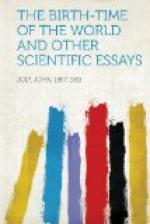3
the early crust of the Earth. Sediments are scarce among these materials.[1]
There can be little doubt that in this underlying floor of igneous and metamorphic rocks we have reached those surface materials of the earth which existed before the long epoch of sedimentation began, and before the seas came into being. They formed the floor of a vaporised ocean upon which the waters condensed here and there from the hot and heavy atmosphere. Such were the probable conditions which preceded the birth-time of the ocean and of our era of life and its evolution.
It is from this epoch we date our geological age. Our next purpose is to consider how long ago, measured in years, that birth-time was.
That the geological age of the Earth is very great appears from what we have already reviewed. The sediments of the past are many miles in collective thickness: yet the feeble silt of the rivers built them all from base to summit. They have been uplifted from the seas and piled into mountains by movements so slow that during all the time man has been upon the Earth but little change would have been visible. The mountains have again been worn down into the ocean by denudation and again younger mountains built out of their redeposited materials. The contemplation of such vast events
[1] For a description of these early rocks, see especially the monograph of Van Hise and Leith on the pre-Cambrian Geology of North America (Bulletin 360, U.S. Geol. Survey).
4
prepares our minds to accept many scores of millions of years or hundreds of millions of years, if such be yielded by our calculations.
THE AGE AS INFERRED FROM THE THICKNESS OF THE SEDIMENTS
The earliest recognised method of arriving at an estimate of the Earth’s geological age is based upon the measurement of the collective sediments of geological periods. The method has undergone much revision from time to time. Let us briefly review it on the latest data.
The method consists in measuring the depths of all the successive sedimentary deposits where these are best developed. We go all over the explored world, recognising the successive deposits by their fossils and by their stratigraphical relations, measuring their thickness and selecting as part of the data required those beds which we believe to most completely represent each formation. The total of these measurements would tell us the age of the Earth if their tale was indeed complete, and if we knew the average rate at which they have been deposited. We soon, however, find difficulties in arriving at the quantities we require. Thus it is not easy to measure the real thickness of a deposit. It may be folded back upon itself, and so we may measure it twice over. We may exaggerate its thickness by measuring it not quite straight across the bedding or by unwittingly including volcanic materials. On the other hand, there




